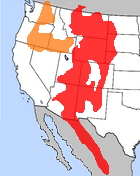Short-horned Lizard
|
|
| Short-horned Lizard | ||||||||||||
|---|---|---|---|---|---|---|---|---|---|---|---|---|
| Missing image Short_Horned_Lizard.jpg Short-horned Lizard | ||||||||||||
| Scientific classification | ||||||||||||
| ||||||||||||
| Species | ||||||||||||
|
P. douglasii |
The Short-horned Lizard is a small lizard that occurs in North America. Like other horned lizards, it is often wrongly called the "Horned Toad", but it is not a toad at all. It is a reptile, not an amphibian. It is one of five species of lizards in Canada.
| Contents |
Taxonomy
The taxonomy of the Short-horned Lizard is in the midst of a major revision based on recent research. As of 2004, accepted nomenclature recognizes two species:
- Phrynosoma douglasii (Bell 1829), the Pygmy Short-horned Lizard, and
- Phrynosoma hernandesi (Girard 1858), the Greater (or Mountain, or Eastern) Short-horned Lizard.
All the subspecies formerly assigned to P. douglasii have been defined to be synonymous with P. hernandesi, and P. douglasii is reserved solely for the population occurring in the Columbia River basin. Recent research considers the former subspecies of P. douglasii, namely P. d. brevirostre, P.d. hernandesi, P.d. ornatissimum or P.d. ornatum an artificial distinction. Because it is unknown where the Mexican taxon P.d. brachycercum fits into all this, the other (former) subspecies are treated actually as the (sole) subspecies P.h. hernandesi.
Herpetologists do not agree on the spelling of P. douglasii, the species is also referenced as P. douglasi, P. douglassii, or P. douglassi. Bell originally named the species after one David Douglass, an early 19th century herpetologist active in the Columbia River region.
The species P. hernandesi is named after Francisco Hernandez, a 16th century Spanish medical doctor and botanist.
Description
Short-horned Lizards are flat-bodied, squat lizards with short spines crowning the head. They have a snub-nosed profile and short legs. The trunk is fringed by one row of pointed scales, while the belly scales are smooth. The color is gray, yellowish, or reddish-brown, and there are two rows of large dark spots on the back. When threatened or aggressive, their colors become more intense.
Females grow to larger sizes than males: females average some 7 cm (about 2.75 inches) from snout to vent (with a maximum total length of about 15 cm) and weigh about 18 g, whereas males have an SVL of only about 5 cm and weigh on the average about 10 g.
Life history
Short-horned Lizards are "sit-and-wait" predators. They feed primarily on ants, but will also take an occasional grasshopper or beetle. Often, they can be found sitting in the vicinity of ant nests or trails. They are most active during midday and burrow at night. They rely extensively on camouflage to avoid predators.
The mating season is in spring (May to June). They are viviparous: the female gives birth to 6 to 11 living offspring in late July or early August, which measure about 24 mm from snout to vent and weigh each about one gram. The young have no horns yet and are able to take care of themselves within a few hours.
Range and habitat
The Short-horned Lizard is the most widely distributed lizard in North America and occurs in the widest range of habitats. It seems able to adapt to habitats ranging from desert to woodlands, requiring only the presence of ants. It can be found in elevations up to 3350 m (11000 ft).
The range of the Short-horned Lizard extends from isolated localizations in Alberta and Saskatchewan in Canada throughout the Great Plains and parts of the Rocky Mountains down south into northern central Mexico. The Phrynosoma douglasii species occurs in the Columbia River basin and the Great Basin.
External links
- The Short-horned Lizard (http://www.nps.gov/brca/shorthorned_lizard.html) from the Bryce Canyon web site.
- The Short-horned Lizard (http://www3.gov.ab.ca/srd/fw/riskspecies/pdf/SAR_29.pdf) in Alberta (PDF file, 1371 KB).
- Description (http://www.dfg.ca.gov/whdab/html/R031.html) from the California Department of Fish and Game.
- Info (http://coloherp.org/geo/species/spephhe.php) from the Colorado Herpetological Society.

